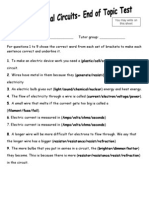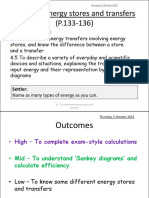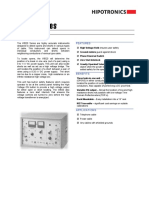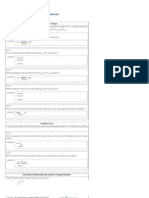9j Summary Sheets
Uploaded by
Smurtman69 IV9j Summary Sheets
Uploaded by
Smurtman69 IV9 J
Summary Sheets
Force fields and electromagnets
Static electricity
An atom consists of a central nucleus with small
particles called electrons moving around it. An atom
normally has no overall charge because it has the
same number of positive and negative charges.
When you rub two materials together, electrons may
be transferred from one material to the other. If the
objects are insulating materials, the object that gains
electrons has a negative charge of static
electricity. The object that loses electrons has a
positive charge.
A positively charged object will attract a negatively charged
object. Two objects with the same charge (both positive or both
negative) will repel each other.
The space around a charged object where it will attract or repel
other charged objects is its electric field. The arrows on the
diagram show the direction a positive charge would move.
Resistance
The resistance of a component is a way of saying how easy or difficult it is for an electric current
to flow through it. The size of a current depends on the resistance of the circuit and on the voltage
that is ‘pushing’ the current:
● the higher the voltage, the higher the current (if the resistance stays the same)
● the higher the resistance, the lower the current (if the voltage stays the same).
All metals conduct electricity, but some metals are better conductors than others. The resistance of
a wire depends on:
● the material from which it is made
● its length (longer wires have higher resistances)
● its thickness (thicker wires have lower resistances).
Calculating resistance
The units for measuring resistance are ohms,
and the symbol is the Greek letter omega (W).
Voltage, resistance and current are related by
this formula:
voltage = current × resistance
To calculate a resistance, you need to measure
the current in amps and the voltage in volts.
resistance =
© Pearson Education Ltd 2015. Copying permitted for
purchasing institution only. This material is not copyright free. 14 Page 1 of 2
9 J
Summary Sheets
Electromagnets
A bar magnet is a permanent magnet, because
it is always magnetic. A wire with electricity
flowing through it has a magnetic field around it.
An electromagnet is a coil of wire with an
electric current flowing through it. It is only
magnetic while the current is flowing. The shape
of the magnetic field of an electromagnet is
similar to the magnetic field of a bar magnet.
You can make an electromagnet stronger by:
● increasing the number of coils of wire
● increasing the size of the current (by
increasing the voltage)
● using an iron core.
Motors
If a wire carrying a current crosses a magnetic
field, the wire will experience a force. This is the
motor effect.
An electric motor consists of a coil of wire in a
magnetic field. When there is a current in the
coil, there is a force on each side of the coil that
makes it turn.
The speed of the motor (or the force it provides)
can be increased by:
● increasing the size of the current
● increasing the strength of the magnetic field
● increasing the number of turns of wire on
the coil.
© Pearson Education Ltd 2015. Copying permitted for
purchasing institution only. This material is not copyright free. 15 Page 2 of 2
You might also like
- 1 - BIOBASE Blood Bank Refrigerator BBR-4V160,250,310 Service ManualNo ratings yet1 - BIOBASE Blood Bank Refrigerator BBR-4V160,250,310 Service Manual20 pages
- Ed Excel Gcse Separate Science ChecklistNo ratings yetEd Excel Gcse Separate Science Checklist101 pages
- Living With Electricity Past Papers ANSWERS - PPTMNo ratings yetLiving With Electricity Past Papers ANSWERS - PPTM14 pages
- You Have 10 Mins: Challenge: Complete The Worksheet On 7Jd-8 Voltage and Resistance 2No ratings yetYou Have 10 Mins: Challenge: Complete The Worksheet On 7Jd-8 Voltage and Resistance 23 pages
- A Topic Questions Paper 1 Islam Topic 4 Forms of ExpressionNo ratings yetA Topic Questions Paper 1 Islam Topic 4 Forms of Expression17 pages
- Summary Sheet Year 8 Metals and Non-Metals:: The Periodic TableNo ratings yetSummary Sheet Year 8 Metals and Non-Metals:: The Periodic Table5 pages
- KS3 Science Download Your Free KS3 Science Lesson PlanNo ratings yetKS3 Science Download Your Free KS3 Science Lesson Plan24 pages
- Metals and Their Uses C1 Revision HigherNo ratings yetMetals and Their Uses C1 Revision Higher31 pages
- Stigma and Discrimination Faced by People With Disabilities Returning To The FATA in Pakistan Web 5No ratings yetStigma and Discrimination Faced by People With Disabilities Returning To The FATA in Pakistan Web 522 pages
- What Are Major Fault in Pressure Transmitter 1706271351No ratings yetWhat Are Major Fault in Pressure Transmitter 170627135124 pages
- Guidance Note 7 Special Locations IEE Guidence Notes No 7 2nd edition Edition Institution Of Electrical Engineers - Download the ebook today and own the complete version100% (2)Guidance Note 7 Special Locations IEE Guidence Notes No 7 2nd edition Edition Institution Of Electrical Engineers - Download the ebook today and own the complete version50 pages
- Basic Electrical & Electronics EngineeringNo ratings yetBasic Electrical & Electronics Engineering72 pages
- 2 Feeder and Transmission Line Protection DDNo ratings yet2 Feeder and Transmission Line Protection DD11 pages
- 34 Top Electronic Device and Circuits Lab Viva Questions and Answers Electronic Device and Circuits Lab Viva QuestionsNo ratings yet34 Top Electronic Device and Circuits Lab Viva Questions and Answers Electronic Device and Circuits Lab Viva Questions7 pages
- TSP The Throttle Position Sensor Signals A and B Have An Incorrect ValueNo ratings yetTSP The Throttle Position Sensor Signals A and B Have An Incorrect Value2 pages
- Analysis of Circuits Containing Ideal Op AmpNo ratings yetAnalysis of Circuits Containing Ideal Op Amp12 pages
- Tds Abb Powerwave 33 60-500kva en 150227No ratings yetTds Abb Powerwave 33 60-500kva en 15022724 pages
- Lighting & Convenience Outlet Layout: General Notes100% (1)Lighting & Convenience Outlet Layout: General Notes1 page































































































